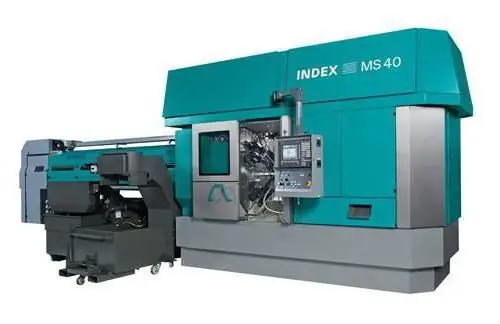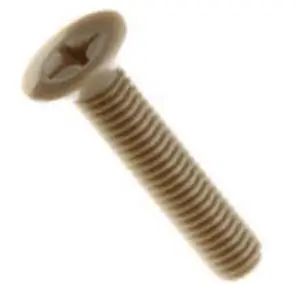2025 Author: Howard Calhoun | [email protected]. Last modified: 2025-01-24 13:10:31
The lead screw is an important part that is used as a motion transducer. It changes rotational motion into translational-rectilinear motion. To do this, it is supplied with a special nut. In addition, it provides movement with a given accuracy.
Prop quality indicators
The screw, as a very important part, must meet many requirements. In order to be used, for example, in a desktop vice, it must be suitable for such parameters as: diametrical size, profile accuracy and thread pitch accuracy, ratio of the screw thread to its support necks, wear resistance, thread thickness. It is also important to note that, depending on the degree of movement accuracy that the screws provide, they can be divided into several accuracy classes from 0 to 4. For example, the lead screws of machine tools must correspond to an accuracy class from 0 to 3. 4 accuracy class is not suitable for use in such equipment.

Material for lead screw blank
As a blank for the production of a screw, an ordinary bar is used, which is cut from high-quality metal. However, it is important to note here that some requirements are imposed on the material serving as a blank. The metal must have good wear resistance, good machinability, and also have a state of stable equilibrium under the conditions of internal stress that occurs after processing. This is very important, as this property will help to avoid deformation of the lead screw during its further use.

For the production of this part with an average accuracy class (2nd or 3rd), which will not be subject to requirements for increased resistance to temperature, use A40G steel, which is medium carbon, with the addition of sulfur and steel 45 with the addition of lead. This alloy improves the workability of the screw and also reduces the surface roughness of the material.
Propeller Profile
There are three screw profiles that are used in the production of the lead screw of a lathe or any other. The profile can be trapezoidal, rectangular or triangular. The most common type is trapezoidal thread. Its advantages include the fact that it is higher in accuracy than a rectangular one. In addition, using a slotted nut, you can adjust the axial clearances with a trapezoidal screw, which occur due to equipment wear.

It is also important to note here that cutting, as well as grinding a trapezoidal thread onto a screw, is much easier than a rectangular one. But at the same time, you need to understand that the accuracy characteristics of a rectangularthe threads are higher than those of the trapezoidal ones. This means that if the task is to create a screw with the best adjustment for accuracy, then you still have to cut a rectangular thread. Trapezoidal screws are not suitable for very precise operations.
Processing screw
The main parts on which the screw is based in the machine are the support necks and collars. The threaded surface of a screw is considered to be its thread. The greatest accuracy in a desktop vice and any other machines with such a screw must be ensured between the execution surface of the part, as well as the main base surface. The technological basis for the production of a lead screw is its center hole. For this reason, in order to avoid deformation, the processing of all these surfaces is carried out using a movable steady rest. The application of this part determines the specific processing of the lead screw.

It is also important to note here that a screw with different accuracy classes is processed to different sizes. Parts that will belong to 0, 1 and 2 accuracy classes are processed up to the 5th quality. Screws belonging to the 3rd accuracy class are processed up to the 6th quality. Screws belonging to the 4th category are also processed up to the 6th grade, but at the same time they have a tolerance margin for the outer diameter.
Centering and threading
In order to obtain an acceptable quality screw, it is necessary to carry out a few more operations. One of them was the centering of the part, which takes place on the turningmachine. The lead screw, or rather, the workpiece for this part, is centered on the specified equipment and the ends are cut to it here. In addition, a workpiece grinding operation is carried out. To do this, use centerless or cylindrical grinding machines in the centers. It is important to add here that grinding in the centers is carried out only for screws of 0, 1 and 2 accuracy classes.

Further, before proceeding with threading, the workpiece must be straightened. It should be noted here that only screws with the 3rd and 4th accuracy class are subjected to this operation. After that, their surface is further polished. A screw-cutting lathe is used as the equipment for cutting threads on the lead screw.
Prop nut description
The lead screw nut is designed to ensure accurate installation movements. In some rare cases, they can be made from a material such as low-friction cast iron. This element must provide constant engagement with the turns of the screw, and also act as a compensating part. You will have to compensate for the gap, which will inevitably occur when the screw wears out. For example, nuts for lead screws used in lathes are made double. This is necessary in order to remove the gap that may occur either due to the production and assembly of the machine, or as a result of wear on its parts.

The feature of the double nut screw is that it has a fixed and a movablepart. The movable part, which is right, can move along the axis of the fixed part. It is this movement that will compensate for the gap. Nut production is carried out only for screws of zero, 1st and 2nd accuracy class. They are made of tin bronze.
What are nuts made of and wear?
The most common materials for the production of this type of parts are aluminum-iron bronzes, according to machine tool standards MT 31-2. In addition to this material, anti-friction cast iron can also be used as a substitute for non-critical screw drives.
It is important to add here that the nut wears out much faster than the lead screw itself. There are several reasons for this:
- the nut thread is poorly protected from any kind of contamination, and it is also quite difficult to clean it from these unnecessary elements;
- it often happens that this element is initially poorly lubricated and this greatly affects the service life;
- when the nut is engaged with the screw, it turns out that all the turns of the second element work simultaneously, but the screw has only those that are engaged with the nut.
For these reasons, nut screws should be inspected more frequently as nut wear sets in rather quickly.
Recommended:
Automatic lathe and its characteristics. Automatic lathe multi-spindle longitudinal turning with CNC. Manufacturing and processing of parts on automatic lathes

Automatic lathe is a modern equipment used mainly in mass production of parts. There are many varieties of such machines. One of the most popular types are longitudinal turning lathes
Household metal lathe: types, description

Household lathe: overview, specifications, manufacturers, features. Desktop lathe: description, varieties, operation, photo
Universal drive: types, device and purpose

Today, the development of technology has advanced quite widely, and those operations that were previously performed by two different devices can be performed by just one machine. A striking example of such progress was the universal drive
Screw press: description of the design, principle of operation and methods of extraction

Screw press has become more and more popular lately. This is due to the fact that this equipment helps to obtain oil from a variety of crops without any problems. It is actively used not only on an industrial scale, but also for private purposes
Screw head screw: use

Modern industry produces a wide variety of fasteners. A countersunk screw is used to create strong and inconspicuous connections. It is used in construction, mechanical engineering, instrument making and other industries, as well as in everyday life

